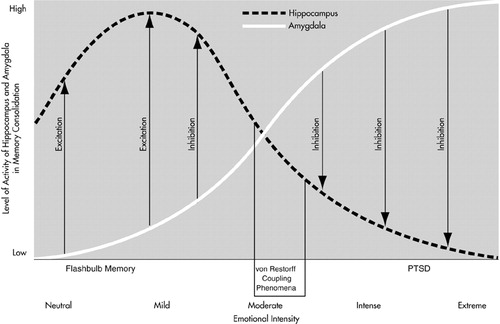Correction
In the article “Memory Mechanisms in Posttraumatic Stress Disorder” by Barry Layton and Robert Krikorian (Summer 2002, vol. 14, no. 3, pp 254–261), Figure 1 (p. 257), the curve for hippocampal activity and the area for the von Restorff effect were incorrectly drawn. The corrected figure appears below.

FIGURE 1. Schematic representation of the theory, illustrating assumptions about the relative levels of memory encoding activity of hippocampus and amygdala (y axis) and the nature of the hypothesized interaction of these structures as a function of emotional intensity (x axis). Activation of the amygdala increases as a function of emotional intensity. At mild to moderate emotional intensity (left side of Figure), the amygdala potentiates hippocampal activity, consistent with flashbulb memory phenomena. At higher levels of amygdala activity, the amygdala begins to inhibit hippocampal activity, and there is a corresponding shift in locus of memory consolidation from the hippocampus to the amygdala. At moderate levels of emotional intensity, the von Restorff coupling effect (augmentation of memory for critical stimuli and amnesia for proximate neutral material) occurs. At the highest levels of emotional intensity (right side of Figure), when amygdala activity (and corresponding inhibition of hippocampus) are greatest, encoding in the hippocampus is suppressed, and memory is mediated by the amygdala, consistent with the peritraumatic amnesia and dissociation observed in posttraumatic stress disorder (PTSD).



